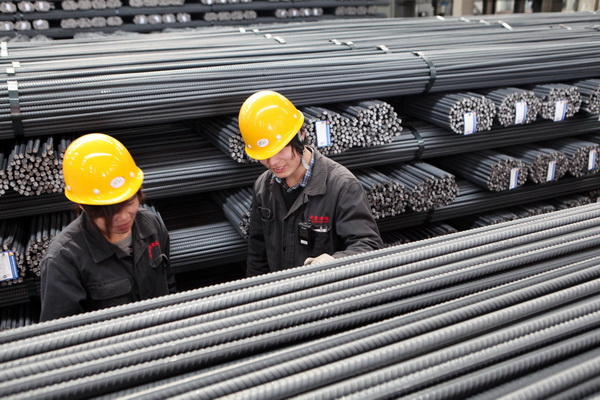

Highlights from the EO print edition, No. 634, Aug 26, 2013

China's Steel Industry Mired in Debt
News, page 1
~ China's steel industry is on the point of bankruptcy, with the latest figures revealing that accumulated debt at 86 large and medium-sized steel companies has already exceeded 3 trillion yuan and that the debt to assets ratio of these firms is close to 70 percent.
~ According to Li Xinchuang (李新创), the head of the China Metallurgical Industry Planning and Research Institute (中国冶金工业规划研究院), it might take less than a year for the first domino to fall and it's not going to be overcapacity but a break down in the funding chain of steel companies that will lead to this wave of bankruptcies.
~ As of the end of June 2013, the amount of debt on the books of 86 large and medium-sized steel enterprises had already exceeded 3 trillion yuan, according to data released by the China Iron and Steel Association (CISA). Of this debt, 1.3 trillion yuan is in outstanding bank loans. The same 86 companies registered profits of only 2.2 billion yuan in the first half of this year and 35 of them were operating at a loss. The debt to asset ratio and accounts receivable at these steel companies is also on the rise. Given these kind of figures, it's extremely unlikely that many of these companies will be able to pay back their bank loans on time.
~ Banks are already starting to tighten their lending requirments and are refusing to extend new credit lines to some steel companies. An executive at one Hebei steel refinery told the EO that if things continue on this way, some companies will go bankrupt before the end of the year.
~ The steel industry is linked to many other sectors of the economy and the coming wave of bankruptcies is likely to impact on the broader real economy.
Original article: [Chinese]
Reform to Lower Taxes and Costs for Certain Enterprises
News, page 2
~ Chinese enterprises that trade domestically and make use of e-commerce will soon enjoy the benefits of a raft of new reforms.
~ In line with the overall advancement of China's economic reform, changes to rules related to domestic trade have been formulated. According to the plan, the cost of land, water and electricity is expected to be reduced for businesses.
~ Reducing the tax burden for trade and commerce-related service industries is one of the primary contents of the reform. The relevant ministries have been discussing a gradual expansion of those exempt from value-added taxes; especially in agriculture.
~ There's also a plan to lower the tax burden for the catering industry, lowering the sales tax from 5 percent to 3 percent.
Original article: [Chinese]
CSRC to Double Its Inspection and Law Enforcement Staff
Market, page 17
~ On Aug 19, the Chinese Securities Regulation Commission (CSRC) posted two articles on its official website about supervision and law enforcement.
~ "There is no road map yet," a source close to CSRC told the Economic Observer. "But the general idea can be found in these two articles."
~ The first article was CSRC Chairman Xiao Gang's speech at a work conference for inspection and law enforcement related to securities and futures, and the second was suggestions for CSRC to further enhance inspection and law enforcement.
~ On Aug 19, Xiao Gang said at the work conference that CSRC had decided to double its inspection and law enforcement staff to 1,200 officers. The new staff will oversee the six major securities and futures exchanges and man inspection and law enforcement teams in Shanghai and Shenzhen.
~ The EO learned that the source of new recruits will mainly be personnel transferred from subordinate agencies under CSRC and recent college graduates.
Original article: [Chinese]
NDRC Investigation into Pricing of Imported Cars Questioned
Automobile, page 33
~ Following high-profile investigations by the anti-monopoly office of the NDRC into high-profit industries like infant formula, medicine and gold, authorities are now reportedly looking at the way that the price of imported vehicles are determined.
~ Despite prominent coverage of the "investigation" by China Central Television (CCTV), China's state broadcaster, as of the time of going to press, the NDRC had not made any official announcement about the rumored investigation. A source close to the NDRC told the EO that authorities had not actually launched an investigation into whether the pricing of imported cars violated anti-monopoly regulations.
~ Many in the auto industry seem to think that the NDRC, just one of three government authorities that monitor monopoly behavior, may have recently tried to get to the bottom of pricing practices in the imported car sector, but it's hard to tell if an "anti-monopoly" investigation has really been launched.
~ Industry sources who did not want to be identified explained that unlike the pricing of infant forumla, which is related to the health of children and which caused much anger among the general population, the high price of imported cars has existed for more than a decade and everyone is aware of it, there's no public outcry.
~ Another expert argued that by simply handing out fines, the NDRC would not be able to address the real problem of "stable" price fixing arrangements that has existed for more than a decade. The same expert added that the NDRC would be simply addressing one aspect of a complicated system for sharing out the profits made from selling imported cars at inflated prices and that it was unlikely that such fines would make any kind of difference.
~ It's interesting to note that since reports of the investigation into the pricing of imported autos began to circulate and following an announcement that they would assist the NDRC in collecting evidence, the top people from CADA or China Automobile Dealers Association (中国汽车流通协会) have now stopped talking to the media.
~ There are a few reasons that could explain why CADA executives have decided to pull their heads in and are now refusing to discuss the issue with the media.
~ One source told the EO that the original push to have the NDRC investigate the pricing of imported cars came from the domestic car retailers who were trying to use the threat of an investigation to pressure Mercedes Benz to alter their current pricing practices. This source says that the media onslaught surrounding the investigation blew up in their faces and led to the possibility of an investigation really occuring.
~ However, there are also many powerful interests who want to keep the current pricing arrangements in place. It extends from those who see the use of fixed minimum pricing among foreign car brands in China as a means to help protect the local car industry to companies that are close to foreign car companies and want to maintain a good relationship with them. Industry associations and government departments that benefit from a strong local car industry, may also have reason to oppose such an investigation.
~ Imported cars accounted for just shy of 6 percent of China's vehicle sales last year. However, the value of foreign car imports however is very high, in 2012, China imported vehicle products worth over $78 billion, with related tax receipts of close to $100 billion yuan.
Original article: [Chinese]

